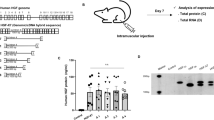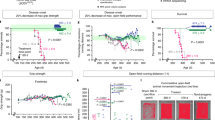Abstract
Neurotrophin treatment has so far failed to prolong the survival of individuals affected with amyotrophic lateral sclerosis (ALS), an incurable motoneuron degenerative disorder. Here we show that intracerebroventricular (i.c.v.) delivery of recombinant vascular endothelial growth factor (Vegf) in a SOD1G93A rat model of ALS delays onset of paralysis by 17 d, improves motor performance and prolongs survival by 22 d, representing the largest effects in animal models of ALS achieved by protein delivery. By protecting cervical motoneurons, i.c.v. delivery of Vegf is particularly effective in rats with the most severe form of ALS with forelimb onset. Vegf has direct neuroprotective effects on motoneurons in vivo, because neuronal expression of a transgene expressing the Vegf receptor prolongs the survival of SOD1G93A mice. On i.c.v. delivery, Vegf is anterogradely transported and preserves neuromuscular junctions in SOD1G93A rats. Our findings in preclinical rodent models of ALS may have implications for treatment of neurodegenerative disease in general.
This is a preview of subscription content, access via your institution
Access options
Subscribe to this journal
Receive 12 print issues and online access
$209.00 per year
only $17.42 per issue
Buy this article
- Purchase on Springer Link
- Instant access to full article PDF
Prices may be subject to local taxes which are calculated during checkout





Similar content being viewed by others
References
Przedborski, S., Mitsumoto, H. & Rowland, L.P. Recent advances in amyotrophic lateral sclerosis research. Curr. Neurol. Neurosci. Rep. 3, 70–77 (2003).
Brown, R.H. Jr. & Robberecht, W. Amyotrophic lateral sclerosis: pathogenesis. Semin. Neurol. 21, 131–139 (2001).
Rothstein, J.D. Of mice and men: reconciling preclinical ALS mouse studies and human clinical trials. Ann. Neurol. 53, 423–426 (2003).
Gurney, M.E. et al. Motor neuron degeneration in mice that express a human Cu,Zn superoxide dismutase mutation. Science 264, 1772–1775 (1994).
Howland, D.S. et al. Focal loss of the glutamate transporter EAAT2 in a transgenic rat model of SOD1 mutant-mediated amyotrophic lateral sclerosis (ALS). Proc. Natl. Acad. Sci. USA 99, 1604–1609 (2002).
Nagai, M. et al. Rats expressing human cytosolic copper-zinc superoxide dismutase transgenes with amyotrophic lateral sclerosis: associated mutations develop motor neuron disease. J. Neurosci. 21, 9246–9254 (2001).
Ferrara, N., Gerber, H.P. & LeCouter, J. The biology of VEGF and its receptors. Nat. Med. 9, 669–676 (2003).
Oosthuyse, B. et al. Deletion of the hypoxia-response element in the vascular endothelial growth factor promoter causes motor neuron degeneration. Nat. Genet. 28, 131–138 (2001).
Lambrechts, D. et al. VEGF is a modifier of amyotrophic lateral sclerosis in mice and humans and protects motoneurons against ischemic death. Nat. Genet. 34, 383–394 (2003).
Storkebaum, E. & Carmeliet, P. VEGF: a critical player in neurodegeneration. J. Clin. Invest. 113, 14–18 (2004).
Azzouz, M. et al. VEGF delivery with retrogradely transported lentivector prolongs survival in a mouse ALS model. Nature 429, 413–417 (2004).
Thoenen, H. & Sendtner, M. Neurotrophins: from enthusiastic expectations through sobering experiences to rational therapeutic approaches. Nat. Neurosci. 5 (Suppl.), 1046–1050 (2002).
Kaspar, B.K., Llado, J., Sherkat, N., Rothstein, J.D. & Gage, F.H. Retrograde viral delivery of IGF-1 prolongs survival in a mouse ALS model. Science 301, 839–842 (2003).
Azari, M.F. et al. Behavioural and anatomical effects of systemically administered leukemia inhibitory factor in the SOD1G93A G1H mouse model of familial amyotrophic lateral sclerosis. Brain Res. 982, 92–97 (2003).
Feeney, S.J. et al. The effect of leukaemia inhibitory factor on SOD1G93A murine amyotrophic lateral sclerosis. Cytokine 23, 108–118 (2003).
Ramer, M.S., Bradbury, E.J., Michael, G.J., Lever, I.J. & McMahon, S.B. Glial cell line–derived neurotrophic factor increases calcitonin gene–related peptide immunoreactivity in sensory and motoneurons in vivo. Eur. J. Neurosci. 18, 2713–2721 (2003).
Raoul, C. & Aebischer, P. ALS, IGF-1 and gene therapy: 'it's never too late to mend'. Gene Ther. 11, 429–430 (2004).
Windebank, A.J. Use of growth factors in the treatment of motor neuron diseases. Adv. Neurol. 68, 229–234 (1995).
Thorne, R.G. & Frey, W.H. II Delivery of neurotrophic factors to the central nervous system: pharmacokinetic considerations. Clin. Pharmacokinet. 40, 907–946 (2001).
Ouary, S. et al. Major strain differences in response to chronic systemic administration of the mitochondrial toxin 3-nitropropionic acid in rats: implications for neuroprotection studies. Neuroscience 97, 521–530 (2000).
Lino, M.M., Schneider, C. & Caroni, P. Accumulation of SOD1 mutants in postnatal motoneurons does not cause motoneuron pathology or motoneuron disease. J. Neurosci. 22, 4825–4832 (2002).
Schafers, M., Geis, C., Brors, D., Yaksh, T.L. & Sommer, C. Anterograde transport of tumor necrosis factor-alpha in the intact and injured rat sciatic nerve. J. Neurosci. 22, 536–545 (2002).
Heerssen, H.M. & Segal, R.A. Location, location, location: a spatial view of neurotrophin signal transduction. Trends Neurosci. 25, 160–165 (2002).
Russell, F.D., Koishi, K., Jiang, Y. & McLennan, I.S. Anterograde axonal transport of glial cell line–derived neurotrophic factor and its receptors in rat hypoglossal nerve. Neuroscience 97, 575–580 (2000).
Watson, F.L. et al. Rapid nuclear responses to target-derived neurotrophins require retrograde transport of ligand-receptor complex. J. Neurosci. 19, 7889–7900 (1999).
D'Ercole, A.J., Ye, P. & O'Kusky, J.R. Mutant mouse models of insulin-like growth factor actions in the central nervous system. Neuropeptides 36, 209–220 (2002).
Ernfors, P., Lee, K.F. & Jaenisch, R. Mice lacking brain-derived neurotrophic factor develop with sensory deficits. Nature 368, 147–150 (1994).
Airaksinen, M.S. & Saarma, M. The GDNF family: signalling, biological functions and therapeutic value. Nat. Rev. Neurosci. 3, 383–394 (2002).
Giess, R. et al. Early onset of severe familial amyotrophic lateral sclerosis with a SOD-1 mutation: potential impact of CNTF as a candidate modifier gene. Am. J. Hum. Genet. 70, 1277–1286 (2002).
Gao, W.Q. et al. IGF-I deficient mice show reduced peripheral nerve conduction velocities and decreased axonal diameters and respond to exogenous IGF-I treatment. J. Neurobiol. 39, 142–152 (1999).
Orrell, R.W., King, A.W., Lane, R.J. & de Belleroche, J.S. Investigation of a null mutation of the CNTF gene in familial amyotrophic lateral sclerosis. J. Neurol. Sci. 132, 126–128 (1995).
Luttun, A. et al. Revascularization of ischemic tissues by PlGF treatment, and inhibition of tumor angiogenesis, arthritis and atherosclerosis by anti-Flt1. Nat. Med. 8, 831–840 (2002).
Caroni, P., Schneider, C., Kiefer, M.C. & Zapf, J. Role of muscle insulin-like growth factors in nerve sprouting: suppression of terminal sprouting in paralyzed muscle by IGF-binding protein 4. J. Cell. Biol. 125, 893–902 (1994).
Acknowledgements
We thank Y. Laroche for advice and A. Bouche, P. Chevron, S. Plaisance, E. Demarsin, D. Dejaegere, B. Hermans, S. Jansen, L. Kieckens, A. Manderveld, K. Maris, S. Meynen, M. Nijs, S. Terclavers, M. Vandewalle and B. Vanwetswinkel for their contribution. E.S. and D.L. are sponsored by the Fund for Scientific Research-Flanders (FWO). This work is supported, in part, by grants from the Muscular Dystrophy Association (3751), the FWO (G.0113.02), the European Union (QLK6-CT-2000-0053) and the Concerted Research Activities, Belgium (GOA2001/09), and by an unrestricted grant from Bristol-Myers-Squibb.
Author information
Authors and Affiliations
Corresponding author
Ethics declarations
Competing interests
P.C. and D.C. are named as inventors on a patent application regarding the use of VEGF to treat amyotrophic lateral sclerosis. The Flanders Interuniversity Institute for Biotechnology (VIB) is one of the joint owners of this patent application, and the said patent application has been licensed to an outside company. Neither VIB nor any of the authors have equity stakes in the company. However, VIB and some of the authors stand to eventually receive royalties.
Supplementary information
Supplementary Fig. 1
Effect of ICV delivery of Vegf on exploring activity, righting activity and grip strength in ALS rat models. (GIF 24 kb)
Supplementary Fig. 2
Effect of ICV delivery of Vegf on body weight loss, disease onset, motor performance and survival in SOD1G93A/HWr rats. (GIF 41 kb)
Supplementary Fig. 3
Axonal transport of VEGF. (JPG 57 kb)
Rights and permissions
About this article
Cite this article
Storkebaum, E., Lambrechts, D., Dewerchin, M. et al. Treatment of motoneuron degeneration by intracerebroventricular delivery of VEGF in a rat model of ALS. Nat Neurosci 8, 85–92 (2005). https://doi.org/10.1038/nn1360
Received:
Accepted:
Published:
Issue Date:
DOI: https://doi.org/10.1038/nn1360
This article is cited by
-
Can the administration of platelet lysates to the brain help treat neurological disorders?
Cellular and Molecular Life Sciences (2022)
-
Alterations of mesenchymal stromal cells in cerebrospinal fluid: insights from transcriptomics and an ALS clinical trial
Stem Cell Research & Therapy (2021)
-
Defining novel functions for cerebrospinal fluid in ALS pathophysiology
Acta Neuropathologica Communications (2020)
-
Sources and lesion-induced changes of VEGF expression in brainstem motoneurons
Brain Structure and Function (2020)
-
Redox active metals in neurodegenerative diseases
JBIC Journal of Biological Inorganic Chemistry (2019)



